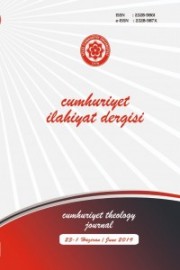Kur’ân’ın İkrar Ettiği İbrahimî Bir Hac Geleneği: Kalâid
An Abrahamic Ḥajj Tradition Accepted by the Qurʾān: Qalāid
Author(s): Muhammed Selman ÇalışkanSubject(s): Islam studies, Sociology of Religion
Published by: Cumhuriyet Üniversitesi İlahyat Fakültesi
Keywords: Tafsīr; Qurʾān; Abraham; Ḥajj, Qalāid;
Summary/Abstract: The Abrahamic tradition that the Arabs value most was ḥajj. The ḥajj, which means to visit Kaʿba was the greatest means of getting closer to Allāh. The Kaʿba was the house of Allāh. And the visitors of the Kaʿba were Allāh’s guests. For this reason, the Arabs used to great respect to the visitors and they never used to attack a man in the ḥarem (the area around the Kaʿba). The same respect included visitors’ travels to the Kaʿba. There were two Abrahamic traditions that ensured the safety of visitors and sacrifices: Ḥaram months and qalāid. Ḥaram months were Dhū l-Qaʿdah, Dhū l-Ḥijjah, Muḥarram and Rajab. And the Arabs did not used to attack anyone in those months. For visits outside the ḥaram months, the visitors used to use the qalāid as a primitive visa. Qalāid is the plural of the word qilāda, meaning necklace. The Arab, who saw the qilādas, used to understand that the person who wore the qilāda wanted to go to the Kaʿba or had returned home from the Kaʿba. Qilādas used to be knitted from wool ropes and they used to be hung on animals’ neck or humps. Sometimes horseshoes used to hang on these qilādas. On the way back from Kaʿba, the barks of the ḥarem trees used to hang on the qilādas instead of the horseshoes. The Qurʾān orders Muslims not to disrespect the qilādas. This order also reveals that the Qurʾān recognizes the qilāda tradition. Allāh’s Apostle (sallallaahu ‘alayhi wa sallam) and Ṣaḥāba are also known to continue this tradition.
Journal: Cumhuriyet İlahiyat Dergisi
- Issue Year: 23/2019
- Issue No: 1
- Page Range: 73-101
- Page Count: 29
- Language: Turkish

